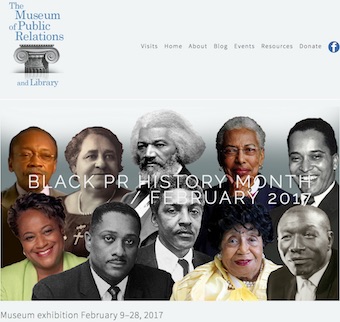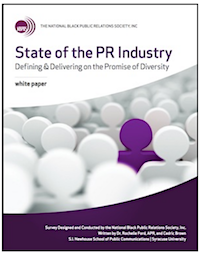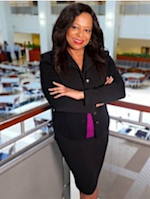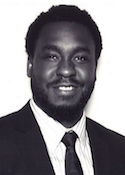Prominent blacks are the focus of the first-ever Black PR History Month Feb. 10-March 8. National Black PR Society, Mike Paul and others have wondered why there are so few blacks in high PR posts.
 |
The Museum of Public Relations is hosting the month-long exhibit at the Baruch College Newman Library, 151 E. 25th st. The kick-off event is Thursday, Feb. 9, 6-9 p.m., at Baruch College, 55 Lexington ave., (25th st.) room 14-220. Reservations are required.
NBPRS is co-producing the event which features Rochelle Ford, chair, PR Department, Syracuse University; Denise Hill, professor, Elon University; Judith Harrison, SVP, Diversity and Inclusion, Weber Shandwick and president of PRSA Foundation; and Donald Singletary, adjunct professor, Baruch College and Syracuse University.
Son of Inez Kaiser Is Speaker
Special guest speaker is Rick Kaiser, son of Inez Kaiser, who taught home economics in public schools for more than 20 years and who in 1957 became the first African-American woman to open a PR firm, handling national clients. She was also the first African-American woman to open a business in Kansas City.
Kaiser, who died July 31, 2016 at the age of 96, had a B.A. in education from Pittsburgh and an M.A. from Columbia University. She was the first African-American woman to join the Greater Kansas City Chamber of Commerce and PRSA. A life-long Republican, she advised the Nixon and Ford Administrations but voted for Barack Obama, according to her son.
Others honored will be Ofield Dukes, Washington, D.C., counselor, and Moss Kendrix, Coca-Cola marketing executive. Some 300 college students are expected to view the exhibit during the month.
Spector: Light Will Be Shined
"Our goal is to shine a light on some of history's most extraordinary black PR professionals-- people not covered in textbooks or taught in the classroom," said Shelley Spector, the Museum's founder and creator of Black PR History Month. "By providing historical role models for our diverse students, we hope that more and more of them will feel a greater sense of connection to the field."
She said that following the event she plans to lobby authors and publishers of PR textbooks to include the contributions of black professionals in their upcoming editions.
"We believe that for every Ivy Lee and Edward Bernays, our books need to include an Ofield Dukes and Inez Kaiser," she said. "To do otherwise is to deprive all our students-- black and white--of the true history of this field."
The program will also feature heads of the Arthur Page Society, PR Council, Institute for PR, Arthur Page Center and PRSA Foundation, PRSSA and the Plank Center to discuss their current initiatives promoting diversity in the PR field.
Patrick Ford, vice chair of Burson-Marsteller, is emcee at the kick-off event.
Study Showed Few Blacks in Top Posts
A study by NBPRS shows that while black PR practitioners are making progress in mid- and senior-level positions in the PR industry, they are still unable to break into the executive suite.
“There’s no speaking about jobs and contracts without addressing the lack of blacks at the senior level in agencies and corporations, and systematic programs in place to correct the situation,” said Deborah Hyman, NBPRS immediate past president.
Of the 20.6 percent of respondents working in the corporate sector, none were executive level professionals, senior vice presidents or chief communication officers.
|
|
At PR agencies, 14 percent had entry level positions and 18 percent were mid-level positions such as account executive (7 percent), account coordinator (7 percent), director (11 percent) and manager (11 percent).
Of those surveyed, 23.8 percent were on the agency side and 20.6 percent were on the corporate side. 22 percent reported as self-employed. Only 1.1 percent replied that they were unemployed.
About 75 percent had graduate degrees, 60 percent began their career in public relations, about 13 percent spoke a foreign language and the ages ranged from 18 to 74, with about 35 percent in the 35 to 44 years old age range. 71 percent were female, 29% male.
Download State of the PR Industry: Defining & Delivering on the Promise of Diversity
Paul Has Campaigned for Inclusion
 |
Mike Paul, SVP-corporate communications, Publicis Media, handling PR for the U.S., Canada and Mexico, has long campaigned for companies to give executive posts to people of color and all minorities. He skipped the 2015 meeting of Seminar, a group of top PR executives, to protest the almost complete lack of people of color in the group.
A poll on the O’Dwyer website Jan. 13-19 asked whether the ad/PR industry practiced “discrimination” or whether talented blacks were attracted to other industries. The vote was 6% for the former and 94% for the latter.Talented people of all backgrounds see the numerous corporate and political pressures that affect the way PR people do their jobs. They often report not only to the CEO but to legal, marketing, and financial. It’s like carrying a heavy burden while walking on thin ice. Keeping silent and shielding others from press questions are sometimes what is required.
PR jobs rank near the top in producing stress, says CareerCast.com, whose rankings are picked up by HuffPost and many other media.
In 2011 it rated “PR officer” as the second most stressful job, moving it up six places from No. 8. “PR executive” was No. 5 on its 2013 list of the ten most stressful jobs.
PR executives are required to do “damage control” which means they have to “think and act quickly under stress,” says CareerCast. “They live in the public eye.” They are also “on call” 24/7 because “news never stops” and they must deal with “potentially hostile” reporters. The occupation is very attractive to recent college grads which makes “getting and keeping a good job that much more difficult,” it adds.
McCaskill, PRSA Director, Is Being Contacted
Andrew McCaskill, SVP of global communications of Nielsen, as the only black on the 17-member board of PR Society of America, has a special duty to see that the Society lives up to the high ideals of Martin Luther King as well as the high ideals of Nielsen and PRSA. He represents the Tri-State district of New York, New Jersey and Connecticut.
|
|
We have not yet been successful in obtaining a response from McCaskill. Laurent Lawrence, PRSA director of PR, an African-American, also does not deal with this reporter nor does Laura Kane, chief communications officer.
Talented people of all stripes note that PR people are unwelcome on the staff of PRSA. It should not only be a major employer of them but set an example of the highest ideals of PR. There were many PR people on the staff in the 1960s and 1970s when ex-journalist Rea Smith presided. A press-friendly culture was present that included inviting reporters to be Silver Anvil judges. That culture ended in 1980 when Patrick Jackson became president.
|
|
He and the board installed association executive Betsy Kovacs as staff head from 1982-1994. Only one PR person was on staff—Donna Peltier. Ad careerist Ray Gaulke succeeded her, lasting until 1999. PR professional Catherine Bolton then served five years after Gaulke's sudden resignation, instituting such press-friendly policies as distributing membership directories to reporters.
But she was replaced in 2006 by Bill Murray, a former executive with the Motion Picture Assn., who was given the title of CEO in 2013. He announced his resignation in 2014, nine months before the end of his contract. He was succeeded in 2015 by Joseph Truncale, whose career was in printing/mailing.
PRSA Silenced McClennan of Publicis
Publicis executive Mark McClennan, who was 2016 elected chair of the Society, has not been allowed to answer an email or phone call from this reporter. We don’t think any self-respecting black would submit to such blockage in press relations given the Society's commitment to the "free flow of information."
The Society has just relocated h.q. to another office downtown without subjecting the decision to the Assembly or the membership. Most PR/ad/media companies and associations are in mid-town. The membership should have had a voice in this decision.
PRSA should again open member contacts to the press, which was the practice until 2006. The APRs, which control 16 of the 17 board seats in 2017, should give up control since they do not represent the 82% of members who are non-APR.
The assistance of McCaskill and the other national board members is needed to accomplish these and other reforms.

 Deborah Hyman
Deborah Hyman Andrew McCaskill
Andrew McCaskill Laurent Lawrence
Laurent Lawrence

 Have a comment? Send it to
Have a comment? Send it to 
No comments have been submitted for this story yet.